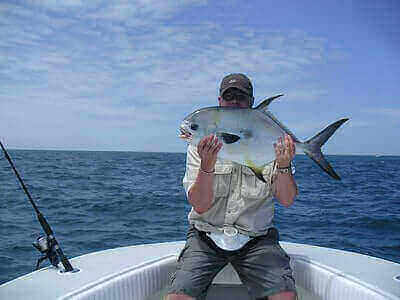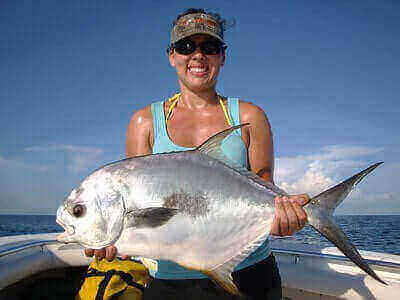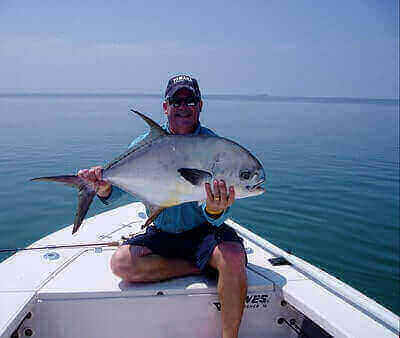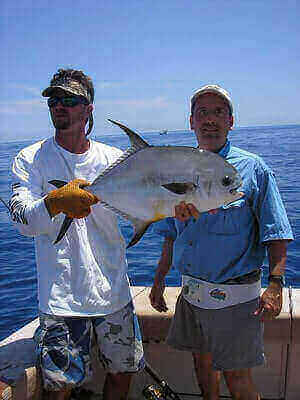Disclosure: We may earn commissions if you purchase products after clicking on a link from our site.
Are you interested in fishing for a permit? Do you want to learn how to catch permit? A permit is an elusive and difficult fish to catch with its good eyesight, good sense of hearing, and sense of smell with two sets of nostrils.
A permit is a very suspicious and spooky fish that will swim away at the slightest noise, movement, or vibration. Moreover, permit tends to ignore lures and flies even if they are right in front of them. They also put up a long, stubborn fight when it is hooked and will run deep whenever they can.

Table of Contents
How To Catch Permit
1. Baitcasting
Baitcasting is a precise and effective fishing method commonly used by anglers targeting permit, a prized saltwater gamefish found in tropical and subtropical waters. This technique involves using a baitcasting reel mounted on a baitcasting rod to accurately cast bait or lures to specific locations where permit are known to feed, such as shallow flats, sandy bottoms, or near structure like reefs and wrecks.
The key to successful baitcasting for permit lies in presenting the bait or lure with precision and finesse, often requiring anglers to make long, accurate casts to reach wary fish. Anglers typically use live bait such as crabs, shrimp, or small fish, or artificial lures that mimic the natural prey of permit, such as crab or shrimp imitations.
Baitcasting reels offer anglers greater control over casting distance and accuracy compared to spinning reels, making them well-suited for targeting permit in a variety of fishing scenarios. Additionally, the ability to quickly adjust the drag and handle powerful runs is crucial when battling these hard-fighting fish. Overall, baitcasting is a preferred method for experienced anglers pursuing permit, offering both the precision and control necessary to entice these challenging gamefish.
2. Fly Fishing
Fly fishing for permit is considered one of the ultimate challenges in saltwater angling, requiring skill, patience, and precision. Anglers often target permit in shallow, clear waters such as flats and sandbars, where these elusive fish feed on crabs, shrimp, and other crustaceans.
Fly fishing for permit involves casting lightweight flies with specialized fly rods and reels to mimic the natural movements of their prey. Accuracy and presentation are crucial, as permit have keen eyesight and are easily spooked.
Anglers must make long, accurate casts to present the fly delicately to cruising permit without causing disturbance. Successful fly patterns for permit often include crab and shrimp imitations tied on sturdy hooks with lifelike movements.
Once a permit takes the fly, anglers must carefully set the hook and be prepared for blistering runs and acrobatic leaps as these powerful fish fight to shake free. Fly fishing for permit offers a thrilling challenge and requires anglers to be attuned to their surroundings, making it a rewarding pursuit for those seeking an ultimate test of skill in saltwater fly angling.

3. Surf Fishing
Surf fishing for permit is an exciting and challenging pursuit that requires anglers to venture into the surf zone along coastal beaches and flats where these prized fish roam. Permit are known for their elusive nature and finicky feeding habits, making them a coveted catch among anglers.
When targeting permit from the surf, anglers typically use long surf rods paired with sturdy reels spooled with heavy-duty monofilament or braided line to handle the powerful runs and swift movements of these fish. The key to success in surf fishing for permit lies in understanding their behavior and preferred habitats, such as shallow flats, channels, and drop-offs adjacent to the beach.
Anglers often use natural baits like live crabs, shrimp, or sand fleas, which are presented on weighted rigs to keep them anchored in the sandy bottom where permit forage. Additionally, artificial lures resembling crabs or shrimp can also be effective when sight-fishing in clear water conditions.
Anglers must carefully watch for signs of feeding permit, such as tailing or cruising fish, and make accurate casts to intercept them. Surf fishing for permit requires patience, keen observation, and skillful presentation, but the thrill of hooking into one of these powerful fish from the surf makes it a rewarding experience for anglers seeking adventure along the shoreline.
4. Wading
Wading for permit is a popular and rewarding fishing method that allows anglers to target these elusive fish in shallow flats, channels, and tidal creeks. Wading anglers typically venture into the water equipped with lightweight fishing gear, such as a sturdy saltwater rod and reel combo spooled with braided line for increased sensitivity and casting distance.
The key to success when wading for permit lies in stealth and patience, as anglers must quietly stalk their prey in shallow water while scanning the surface for signs of feeding fish. Permit are often found tailing or cruising in search of crabs, shrimp, and other crustaceans along the bottom, making them susceptible to well-presented baits and lures.
Anglers may opt to use live or artificial baits like crabs, shrimp, or small baitfish rigged on light tackle to entice permit into striking. Additionally, fly fishing enthusiasts can target permit with lightweight fly rods and specialized crab or shrimp patterns designed to mimic their natural prey. Wading for permit offers anglers an immersive and exhilarating experience, allowing them to connect with the coastal environment while pursuing one of the most challenging and coveted game fish in shallow water habitats.

Permit Fishing Tackle
You don’t need any high-tech or expensive fishing gear to catch permit. A 7-foot medium light fishing rod and a medium spinning reel with a 20 lb braided line will get the job done. Use a fluorocarbon or monofilament leader and a 2/0 – 4/0 circle hook.

How To Catch Permit In The Keys
When fishing for permit in the Keys, look for areas of the water with current. Rips, ruffles, seams, and bumps will be areas where you can find permit. Additionally, these areas provide cover for permit and keep it safe from predators. Shrimps, crabs, and crustaceans are some of the baitfish that they eat. Baitcasting and fly fishing are fishing methods used when fishing for permit.
Best Baits For Permit
- Crabs (Live or dead)
Using crabs as bait for permit fishing is a time-tested strategy that can yield excellent results. Permit are known for their voracious appetite for crustaceans, particularly crabs, making them a prime target for anglers seeking to entice these elusive fish. When using crabs as bait, it’s essential to choose the right size and species to match the preferences of permit in the area.
Blue crabs, sand crabs, and mole crabs are among the most effective choices, as they closely resemble the natural prey of permit found in coastal waters. Anglers typically rig live crabs on a hook using a simple but secure setup, allowing the bait to move naturally in the water to attract the attention of passing permit.
Additionally, artificial crab lures can also be effective, especially when fishing in areas where live bait is scarce or difficult to obtain. Whether using live or artificial crabs, presenting the bait in areas where permit are known to frequent, such as shallow flats, channels, and tidal creeks, increases the likelihood of success when targeting these prized game fish.
2. Shrimp
Shrimp is a highly effective bait for targeting permit, prized for its natural appeal to these discerning game fish. Permit are known to feed on a variety of crustaceans, including shrimp, making it a popular choice among anglers seeking success in permit fishing.
Whether using live or fresh dead shrimp, presenting the bait in a natural and enticing manner is crucial for enticing bites from these wary fish. Anglers often rig shrimp on a hook using a simple Carolina or drop-shot rig, allowing the bait to move freely in the water column to mimic the natural behavior of live prey.
When fishing with live shrimp, keeping them lively and active on the hook can further enhance their appeal to permit. Additionally, artificial shrimp lures, such as soft plastic imitations, can also be effective, particularly when fishing in areas where live bait is scarce or impractical to use. Overall, presenting shrimp bait in areas where permit are known to congregate, such as shallow flats, sandbars, and channel edges, increases the chances of enticing these elusive game fish to strike.
3. Shellfish
Shellfish can be a tantalizing bait option when targeting permit, offering anglers a chance to entice these finicky fish with a natural and enticing offering. Permit are known to forage on a variety of crustaceans and shellfish, making options like crabs, clams, and mussels highly effective choices.
When using shellfish as bait for permit fishing, anglers often opt for fresh, whole specimens to maximize their appeal. Crabs, in particular, are a favored bait for permit due to their natural occurrence in the permit’s diet and their ability to resist the attention of other bait thieves.
Anglers can present shellfish baits using a variety of rigging techniques, including Carolina or drop-shot rigs, allowing the bait to move naturally with the current and attract the attention of passing permit.
Additionally, anglers may also use artificial shellfish imitations, such as soft plastic crab or clam lures, to mimic the appearance and movement of natural prey. When targeting permit in shallow flats or along coastal edges, presenting shellfish baits in areas with abundant natural food sources can increase the likelihood of enticing these prized game fish to strike.
4. Sea Urchin
Sea urchin can be an unconventional yet effective bait option for permit fishing in certain coastal areas where these creatures are abundant. Permit are known to feed on a variety of crustaceans and marine invertebrates, including sea urchins, making them a potential target for anglers seeking to entice these elusive fish.
When using sea urchin as bait for permit fishing, anglers typically gather fresh specimens from rocky intertidal zones or shallow coastal waters. The spiny shell of the sea urchin provides natural protection and can be rigged onto hooks using specialized bait rigs or simply threaded onto the hook through the soft tissue.
The rich, flavorful meat of the sea urchin emits enticing scent and taste cues that can attract permit in search of a meal. Anglers may present sea urchin baits using a variety of techniques, including drift fishing along coastal currents, casting near mangrove edges, or bottom fishing in shallow flats where permit are known to forage.
While sea urchin may not be as commonly used as other bait options for permit fishing, its unique properties and availability in certain coastal areas make it a worthwhile consideration for anglers looking to diversify their bait arsenal and increase their chances of hooking into these prized game fish.

Permit Fishing Tips
1. Permit has good eyesight, sense of smell, and hearing.
2. Permit is a very suspicious fish that can ignore lures and flies even if they are right in front of them.

3. Permit can put up a long and stubborn fight when hooked. It will run back to structures when they feel resistance.
4. They are usually found around wrecks, rock piles, and grass beds.

5. Live bait, lures, and jigs can be used to catch permits.
6. If you see the tail of a fish sticking out of the water, that might be a permit feeding down. Get a fly in front of them to get a bite.

7. Fly fishing and baitcasting are two fishing methods used by anglers to catch permits.
8. Permits can also be found around reefs, inlets, and passes, along the flats, and surfing in the surf.

9. A permit is very skittish on the flats because it is not its natural habitat and it feels exposed. It can’t resist the flats because it is a good hunting ground for crabs.
10. You can also fish for a permit by wading.

11. Small shallow boats can be used for flats fishing. Always approach the permit from the down sun to avoid casting a shadow on the bottom in front of you.


The Bottom Line
A permit can be found along the Atlantic from Massachusetts to Brazil. It is an elusive fish with great eyesight, a good sense of hearing, and smell. A permit can be frustrating to catch at times as it has the habit of ignoring bait, especially dead crabs, even if it is right in front of it. When hooked, it will put up a long and hard fight, even running deep if it can do that.
In this article, we share information about catching permits like fishing methods, their behavior, fishing tips, and the equipment needed to catch it.
If you are also interested in other fish like hogfish, garfish, and bonefish, you can read these articles on how to catch hogfish, how to catch garfish, and how to catch bonefish.